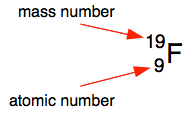|
Chemguide: Support for CIE A level Chemistry Learning outcome 1.2 Isotopes Learning outcome 1.2.1 This statement is simply a definition of isotopes. The number of neutrons in an atom can vary within small limits. For example, there are three kinds of carbon atom 12C, 13C and 14C. They all have the same number of protons, but the number of neutrons varies.
These different atoms of carbon are called isotopes. The fact that they have varying numbers of neutrons makes no difference whatsoever to the chemical reactions of the carbon. Isotopes are atoms which have the same atomic number (proton number) but different mass numbers (nucleon numbers). They have the same number of protons but different numbers of neutrons. Learning outcome 1.2.2 This just wants you to recognise that the information about isotopes can be given simply using the format shown below.
Obviously the smaller number must be the atomic number (proton number), because the mass number (nucleon number) counts protons and neutrons. Learning outcome 1.2.3 This wants you to know why isotopes of an element all have the same chemical properties. The chemistry of any element is governed by the number and arrangement of its electrons. Remember that in a neutral atom, the number of electrons is the same as the number of protons. In atoms with the same atomic number, there are always the same number of protons, and therefore the same number of electrons. A difference in the number of neutrons has no effect this whatsoever. Learning outcome 1.2.4 This statement expects you to be able to explain (in two simple cases) why isotopes of an element can have different physical properties. Difference in mass Obvious really! For example, there are several isotopes of uranium of which two are important: U-235 and U-238. Most of the mass of the atom is concentrated in the nucleus. U-238 has 3 more neutrons than U-235, and so its mass is bound to be greater. Difference in density Different isotopes of the same element have the same number of protons and electrons. The radius of the atom is governed by arrangement of the electrons, and so will be the same in all the isotopes. If you imagine, say, uranium atoms packed together in a solid, the packing and the distance between the atoms will be identical in both U-235 and U-238. But U-238 atoms have a slightly greater mass than U-235. So in any given volume, the mass of the U-238 atoms will be more than the mass of the U-235. Therefore its density is greater.
© Jim Clark 2019 |
|||||||||||||||||
